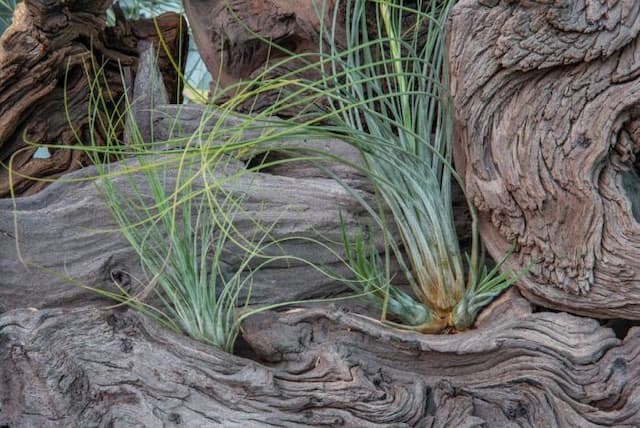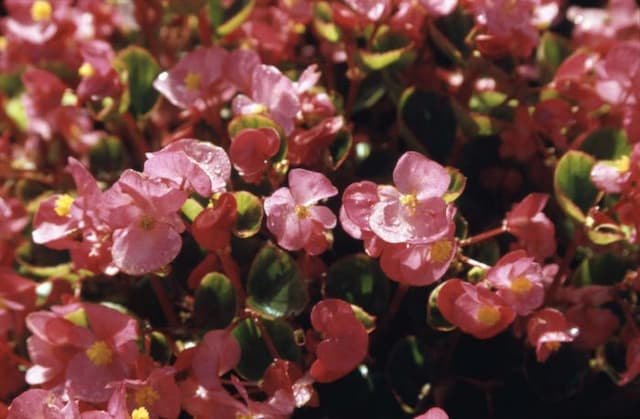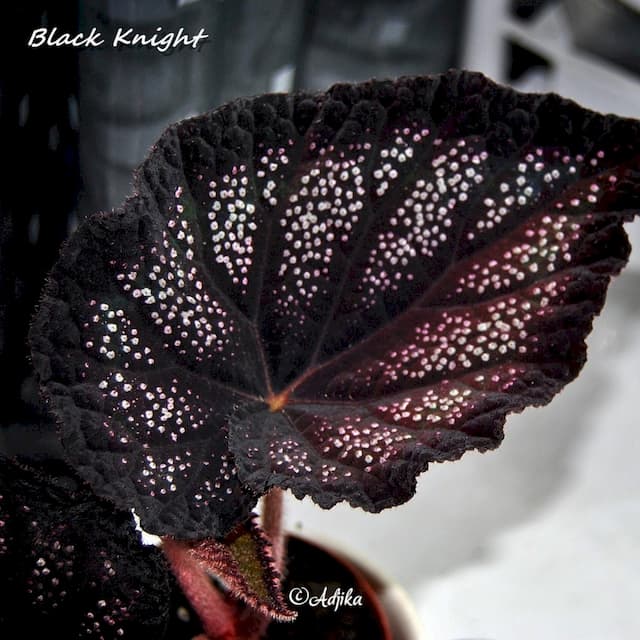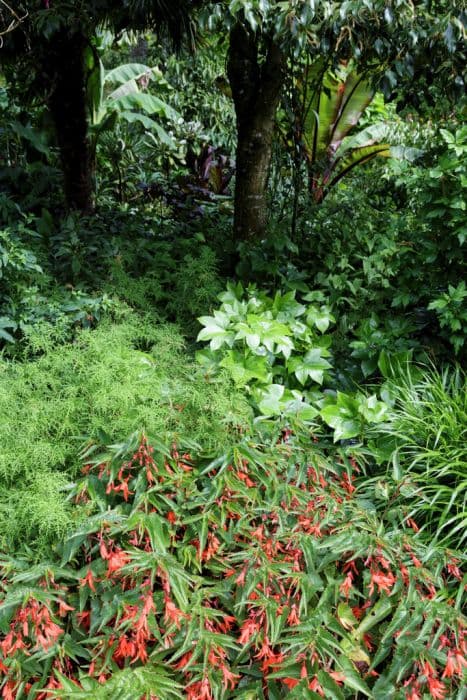Sutherland Begonia Begonia sutherlandii (T)

ABOUT
Begonia sutherlandii, commonly known as Sutherland Begonia, is a charming plant that exhibits an array of attractive features. It typically presents a cascading habit, making it an ideal candidate for hanging baskets and elevated planters. The leaves are a distinctive part of this plant, typically being heart-shaped with pointed tips and bearing a bright green color. The leaf edges are often delicately toothed, giving them a serrated appearance. During its blooming season, the Sutherland Begonia produces a profusion of flowers which can be a spectacular sight. The flowers themselves are small and bell-shaped, hanging in loose clusters. They usually have a soft orange hue, which provides a delightful contrast against the green foliage. The blooms are characterized by their delicate petals and can add a touch of tropical warmth to the environment. The plant's stems can be slender and, depending on individual plant care and growth conditions, might exhibit a pale green or reddish coloration. These stems support the overall arching form of the plant and allow the leaves and flowers to drape gracefully. Overall, the Sutherland Begonia is a visually appealing plant, with a combination of vivid leaves and cheery blooms that make it a favorite among gardeners and plant enthusiasts.
About this plant
 Names
NamesFamily
Begoniaceae
Synonyms
Sutherland Begonia
Common names
Begonia sutherlandii var. cinnabarina, Begonia aconitifolia, Begonia rehmannii, Begonia kirkii.
 Toxicity
ToxicityTo humans
Sutherland Begonia is generally considered non-toxic to humans. However, like many plants, it may cause minor irritation if ingested or if the sap comes into contact with the skin or eyes. Ingesting any part of the plant could potentially result in gastrointestinal discomfort such as nausea, vomiting, or diarrhea. If a significant amount is consumed, or if symptoms persist, seeking medical attention is advisable.
To pets
Sutherland Begonia is also generally recognized as non-toxic to pets. While the ingestion of plant material might lead to mild gastrointestinal upset, such as vomiting or diarrhea in sensitive pets, serious toxicity is not expected. It is always a good practice to prevent pets from eating plants, as individual reactions can vary. If a pet appears ill after consuming any part of the plant, consult with a veterinarian.
 Characteristics
CharacteristicsLife cycle
Perennials
Foliage type
Deciduous
Color of leaves
Green
Flower color
Orange
Height
1-2 feet (30-60 cm)
Spread
1-2 feet (30-60 cm)
Plant type
Herb
Hardiness zones
10
Native area
Africa
Benefits
 General Benefits
General Benefits- Ornamental value: Begonia sutherlandii is known for its attractive foliage and vibrant orange flowers, which can enhance the aesthetic appeal of gardens and indoor spaces.
- Drought tolerance: It has the ability to withstand periods of low water availability, making it suitable for xeriscaping and low-maintenance gardens.
- Shade tolerance: This plant can thrive in shaded environments, which makes it an ideal choice for areas that receive limited sunlight.
- Easy propagation: Begonia sutherlandii can be easily propagated through leaf cuttings or division, allowing gardeners to increase their stock cost-effectively.
- Compact growth: With its compact growth habit, this plant is suitable for container gardening and small spaces.
- Long blooming season: It has a prolonged blooming period, providing color and interest in the garden for an extended time.
- Attracts pollinators: The brightly colored flowers of Begonia sutherlandii attract a variety of pollinators, which is beneficial for the local ecosystem.
 Medical Properties
Medical Properties- This plant is not used for medical purposes.
 Air-purifying Qualities
Air-purifying QualitiesThis plant is not specifically known for air purifying qualities.
 Other Uses
Other Uses- Begonia sutherlandii's tubers can be dried and ground into a fine powder to be used as a basic starch in craft projects, such as homemade glue or paste.
- The waxy leaves of this plant when treated properly, can serve as natural wrappers for small food items in culinary presentations.
- This plant can be used in a terrarium environment to create a miniature landscape because of its texture and foliage.
- Due to its vibrant colors and patterns, the petals of Begonia sutherlandii can be incorporated into art projects such as pressed flower crafts or botanical prints.
- The plant's dense foliage can provide shelter and habitat enhancement for beneficial insects within a garden ecosystem.
- Ornamental pieces such as festive garlands or table centerpieces can include Begonia sutherlandii for bursts of color.
- Begonia sutherlandii's stems are sometimes used in the creation of small, hand-made baskets or as a natural binding material in traditional crafting.
- When conducting plant studies and education, Begonia sutherlandii can be used to illustrate plant propagation techniques due to its ability to propagate easily from leaf cuttings or divisions.
- The contrast of its bright flowers against dark foliage makes Begonia sutherlandii a natural choice for photographic subjects, especially for macro photography enthusiasts.
- Its leaves, when coated with a thin layer of silicone, can be used as molds for creating decorative concrete or plaster elements such as stepping stones or wall hangings in garden design.
Interesting Facts
 Feng Shui
Feng ShuiThe Begonia is not used in Feng Shui practice.
 Zodiac Sign Compitability
Zodiac Sign CompitabilityThe Begonia is not used in astrology practice.
 Plant Symbolism
Plant Symbolism- Caution - Begonias typically symbolize caution or warning due to their delicate and diverse appearances, which can signal to pay closer attention to one's environment or relationships.
- Uniqueness - The unique attributes and bright coloration of Begonia sutherlandii can represent individuality and standing out from the crowd.
- Harmony - They may also embody a sense of harmony and balance, as many gardeners use begonias to create aesthetically pleasing plant arrangements.
- Gratitude - Giving Begonia sutherlandii as a gift can express appreciation and thankfulness, making it a suitable token of gratitude.
 Water
WaterSutherland Begonia should be watered regularly, but allow the soil to dry out slightly between waterings. Water when the top inch of the soil feels dry, giving enough water so it runs through the drainage holes. This might equate to approximately 1 gallon per week, depending on environmental conditions like temperature and humidity. Over-watering can lead to root rot, so it's crucial to ensure good drainage and avoid letting the plant sit in water. During the winter, reduce watering to prevent the soil from becoming too damp as the plant enters a dormant phase.
 Light
LightSutherland Begonia thrives in bright, indirect light. It prefers a spot that receives plenty of light but is shielded from the direct harsh rays of the sun, especially during the hottest parts of the day. An east or west-facing window with a sheer curtain is often ideal for providing the right amount of light without scorching the leaves.
 Temperature
TemperatureSutherland Begonia does well in warm temperatures, ideally between 60°F and 75°F. It can tolerate a minimum temperature of around 50°F, but cold drafts and temperatures below this can cause harm. The plant should be kept away from extreme cold or heat sources to maintain a stable environment.
 Pruning
PruningPruning Sutherland Begonia helps maintain its shape and encourages bushier growth. Prune in late winter or early spring before new growth begins, trimming back leggy stems and removing any dead or withered leaves. Pruning can be done every couple of months, just be cautious not to over-prune as this can stress the plant.
 Cleaning
CleaningAs needed
 Soil
SoilSutherland Begonia thrives in well-draining, fertile soil with a mix of peat, pine bark, and perlite or sand. Maintain a soil pH of 5.5 to 6.5 for optimal growth.
 Repotting
RepottingSutherland Begonia should be repotted every 1-2 years, or when the plant becomes root-bound.
 Humidity & Misting
Humidity & MistingSutherland Begonia prefers high humidity levels, ideally between 50% to 70%, for optimal growth.
 Suitable locations
Suitable locationsIndoor
Provide bright, indirect light and maintain high humidity.
Outdoor
Place in partial shade and protect from harsh elements.
Hardiness zone
9-11 USDA
 Life cycle
Life cycleBegonia sutherlandii, also known as Sutherland's begonia, begins its life cycle as a seed, which upon germination produces a small seedling. The seedling develops into a young plant with characteristic asymmetrical begonia leaves. As it matures, Sutherland's begonia forms a tuberous root system that allows it to survive periods of dormancy, typically induced by colder temperatures or drought. During the growing season, it produces distinctive clusters of pendulous, orange-colored flowers which are pollinated by insects, leading to the formation of seed capsules. After pollination, seeds mature and are dispersed from the dehiscent capsules, ready to germinate and start a new cycle. In colder climates, the above-ground plant may die back in the winter, with the tuberous roots remaining dormant until favorable conditions return in the spring.
 Propogation
PropogationPropogation time
Spring-Early Summer
The most popular method of propagation for Begonia sutherlandii, often called Sutherland begonia, is through leaf cuttings. This method is ideally performed in the spring or early summer, which allows the plant sufficient time to establish itself during the growing season. To propagate by leaf cuttings, a healthy, mature leaf along with a bit of the stem is cut from the mother plant. The petiole, or leaf stalk, is typically trimmed to about 1 to 1.5 inches (2.5 to 3.8 centimeters) and then dipped in rooting hormone to encourage root growth. This cutting is then planted in a well-draining soil mix and kept under bright, indirect light, with consistent moisture but not waterlogged. Roots usually develop within a few weeks, after which the new plant can gradually be accustomed to the same conditions as the mature plants.

![Begonia [Allure]](/_next/image?url=https%3A%2F%2Fplants-admin.emdemapps.com%2Fimages%2Fplants%2F%2Fimages%2F604b5b9006ab9.png&w=640&q=75)







